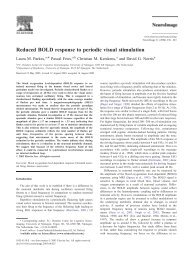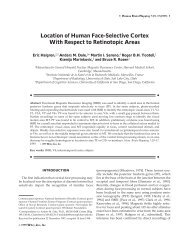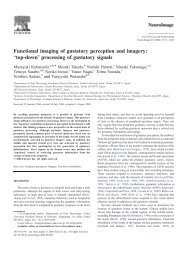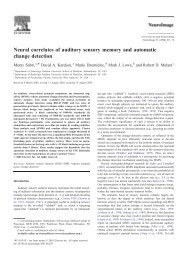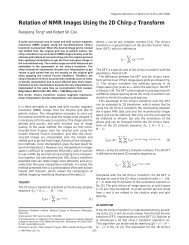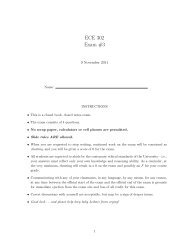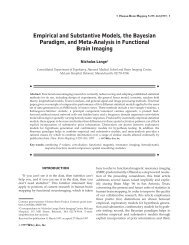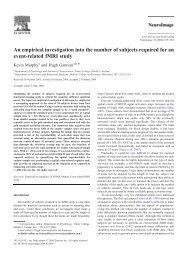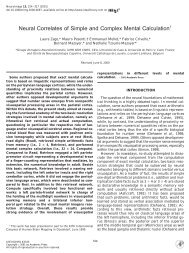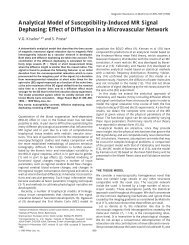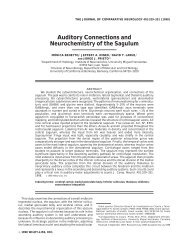Bias and Efficiency in fMRI Time-Series Analysis - Purdue University
Bias and Efficiency in fMRI Time-Series Analysis - Purdue University
Bias and Efficiency in fMRI Time-Series Analysis - Purdue University
Create successful ePaper yourself
Turn your PDF publications into a flip-book with our unique Google optimized e-Paper software.
200 FRISTON ET AL.<br />
FIG. 3. Spectral densities (top) <strong>and</strong> correspond<strong>in</strong>g autocorrelation<br />
functions (bottom) for the residual terms of a <strong>fMRI</strong> time series<br />
averaged over 512 voxels. Three cases are shown: (i) An AR(16)<br />
model estimated us<strong>in</strong>g the Yule–Walker method (this is taken to be<br />
a good approximation to the true correlations). The “bump” <strong>in</strong> the<br />
spectrum at around 1/32 Hz may reflect harmonics of r<strong>and</strong>om variations<br />
<strong>in</strong> trial-to-trial responses (every 16 s). (ii) An AR(1) model<br />
estimate us<strong>in</strong>g the same method. (iii) For a model of the form (q 1 /f <br />
q 2 ) where f is frequency <strong>in</strong> Hz. These data came from a s<strong>in</strong>gle-subject,<br />
event-related, s<strong>in</strong>gle-word-presentation <strong>fMRI</strong> study acquired with<br />
multislice EPI at 2 T with a TR of 1.7 s. The words were presented<br />
every 16 s. The data were globally normalized, <strong>and</strong> fitted eventrelated<br />
responses (Josephs et al., 1997) were removed. The 512<br />
voxels were selected on the basis of a nontrivial response to acoustic<br />
stimulation, based on the F ratio <strong>in</strong> a conventional SPM analysis<br />
(P 0.001 uncorrected). This ensured that the ensu<strong>in</strong>g gray-matter<br />
voxels represented a fairly homogeneous population <strong>in</strong> terms of their<br />
functional specialization.<br />
“gold st<strong>and</strong>ard” <strong>and</strong> evaluate simpler, but commonly<br />
used, models <strong>in</strong> relation to it. In other words we will<br />
consider the AR(16) model as an approximation to the<br />
true underly<strong>in</strong>g correlations. The problem of estimat<strong>in</strong>g<br />
serial correlations is highlighted <strong>in</strong> Fig. 3. Here the<br />
residuals from a long (512-scan, TR 1.7 s) time series<br />
were used to estimate the spectral density <strong>and</strong> associated<br />
autocorrelation functions (where one is the<br />
Fourier transform of the other) us<strong>in</strong>g the Yule–Walker<br />
method with an autoregression order of 16 (see Appendix<br />
A). The data came from a s<strong>in</strong>gle-subject eventrelated<br />
study us<strong>in</strong>g sparse s<strong>in</strong>gle-word presentations<br />
every 16 s. Evoked responses were removed follow<strong>in</strong>g<br />
global normalization. Estimates of the autocorrelation<br />
functions <strong>and</strong> spectral densities us<strong>in</strong>g a commonly assumed<br />
AR(1) model (Bullmore et al., 1996) <strong>and</strong> a modified<br />
1/f model (Zarahn et al., 1997) are also shown. The<br />
AR(1) is <strong>in</strong>adequate <strong>in</strong> that it fails to model either<br />
long-range (i.e., low frequencies) or <strong>in</strong>termediate correlations.<br />
The modified 1/f model shown here is a good<br />
approximation for the short-range <strong>and</strong> <strong>in</strong>termediate<br />
correlations but fails to model the long-range correlations<br />
as well as it could. Any discrepancy between the<br />
assumed <strong>and</strong> the actual correlation structure means<br />
that, when the data are whitened <strong>in</strong> accord with the<br />
assumed models, the st<strong>and</strong>ard error of the contrast is<br />
biased. This leads directly to bias <strong>in</strong> the ensu<strong>in</strong>g statistics.<br />
For example the T statistic is simply the quotient<br />
of the contrast <strong>and</strong> its estimated st<strong>and</strong>ard error.<br />
It should be noted that the simple models would fit<br />
much better if drifts were first removed from the time<br />
series. However, this drift removal corresponds to<br />
high-pass filter<strong>in</strong>g <strong>and</strong> we want to make the po<strong>in</strong>t that<br />
filter<strong>in</strong>g is essential for reduc<strong>in</strong>g the discrepancy between<br />
assumed <strong>and</strong> actual correlations (see below).<br />
This bias is illustrated <strong>in</strong> Fig. 4 under a variety of<br />
model-specific m<strong>in</strong>imum-variance filters. Here the regressors<br />
from the epoch- <strong>and</strong> event-related designs <strong>in</strong><br />
Fig. 2 were used as the design matrix X, to calculate<br />
the contrast variance <strong>and</strong> bias <strong>in</strong> the estimate of this<br />
variance accord<strong>in</strong>g to Eq. (3) <strong>and</strong> Eq. (4), where<br />
V i V AR(16) ,<br />
V a V i<br />
V AR(1)<br />
V 1/f<br />
1<br />
1<br />
i<br />
“correct” model<br />
1<br />
K<br />
, S K AR(1) AR1 model<br />
1<br />
.<br />
K 1/f<br />
1/f model<br />
1 “none”<br />
The variances <strong>in</strong> Fig. 4 have been normalized by the<br />
m<strong>in</strong>imum variance possible (i.e., that of the “correct”<br />
model). The biases are expressed <strong>in</strong> terms of the proportion<br />
of variance <strong>in</strong>correctly estimated. Obviously<br />
the AR(16) model gives maximum efficiency <strong>and</strong> no<br />
bias (bias 0) because we have used the AR(16) estimates<br />
as an approximation to the actual correlations.<br />
Any deviation from this “correct” form reduces efficiency<br />
<strong>and</strong> <strong>in</strong>flates the contrast variance. Note that<br />
misspecify<strong>in</strong>g the form for the serial correlations has<br />
<strong>in</strong>flated the contrast variance more for the event-related<br />
design (bottom) relative to the epoch-related design<br />
(top). This is because the regressors <strong>in</strong> the epochrelated<br />
design correspond more closely to eigenvectors<br />
of the <strong>in</strong>tr<strong>in</strong>sic autocorrelation matrix (see Worsley



